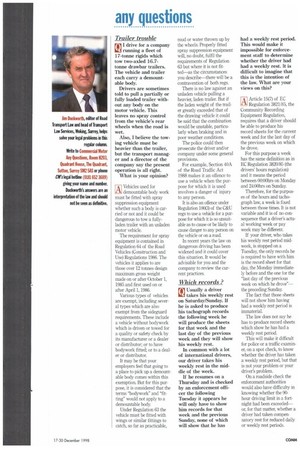any questions
Page 83

If you've noticed an error in this article please click here to report it so we can fix it.
Trailer trouble
I drive for a company running a fleet of 17-tonne rigids which tow two-axled 16.7tonne drawbar trailers. The vehicle and trailer each carry a demountable body.
Drivers are sometimes told to pull a partially or fully loaded trailer without any body on the motor vehicle. This leaves no spray control from the vehicle's rear wheels when the road is wet.
Also, I believe the towing vehicle must be heavier than the trailer, but the transport manager and a director of the company say the present operation is all right.
What is your opinion?
Vehicles used for demountable body work must be fitted with spray suppression equipment whether such a body is carried or not and it could be dangerous to tow a fullyladen trailer with an unladen motor vehicle.
The requirement for spray equipment is contained in Regulation 64 of the Road Vehicles (Construction and Use) Regulations 1986. The vehicles it applies to are those over 12 tonnes design maximum gross weight made on or after October 1, 1985 and first used on or after April 1, 1986.
Various types of vehicles are exempt, including several types which are also exempt from the sideguard requirements. These include a vehicle without bodywork which is driven or towed for a quality or safety check by its manufacturer or a dealer or distributor; or to have bodywork fitted; or to a dealer or distributor.
It may be that your employers feel that going to a place to pick up a demountable body comes within this exemption. But for this purpose, it is considered that the terms "bodywork" and "fitting" would not apply to a demountable body Under Regulation 63 the vehicle must be fitted with wings or similar fittings to catch, so far as practicable, mud or water thrown up by the wheels. Properly fitted spray suppression equipment will, no doubt, fulfil the requirements of Regulation 63 but where it is not fitted—as the circumstances you describe—there will be a contravention of both regs.
There is no law against an unladen vehicle pulling a heavier, laden trailer. But if the laden weight of the trailer greatly exceeded that of the drawing vehicle it could be said that the combination would be unstable, particularly when braking and in poor weather conditions.
The police could then prosecute the driver and/or company under some general provisions.
For example, Section 40A of the Road Traffic Act 1988 makes it an offence to use a vehicle when the purpose for which it is used involves a danger of injury to any person.
It is also an offence under Regulation 100(3) of the C&U regs to use a vehicle for a purpose for which it is so unsuitable as to cause or be likely to cause danger to any person on the vehicle or on a mad.
In recent years the law on dangerous driving has been widened and it could cover this situation. It would be advisable for you and the company to review the current practices.












































































































































